
Climate Change and Food Security
Tropospheric (ground level) ozone
Tropospheric (ground level) ozone
Tropospheric / ground level ozone is highly damaging to crops and it increases as global warming increases. But this large adverse effect is not in the climate crop models.
Ozone has significant adverse effects on crop yields pasture and forest growth. Increasing ozone concentrations in the future with or without CO2 fertilization will negatively impact on plant production, possibly increasing exposure to pests. (IPCC 2007 WG2 Ch5 Box 5.2)
Ozone has significant adverse effects on crop yields pasture and forest growth. Increasing ozone concentrations in the future with or without CO2 fertilization will negatively impact on plant production, possibly increasing exposure to pests. (IPCC 2007 WG2 Ch5 Box 5.2)
MIT, Human-generated Ozone Will Damage Crops, Reduce Production.
J. Reilly et al Energy Oct 2007
Even assuming that best-practice technology for controlling ozone is adopted worldwide, we see rapidly rising ozone concentrations in the coming decades," said John M. Reilly, associate director of the MIT Joint Program on the Science and Policy of Global Change. Without emissions restrictions, growing fuel combustion worldwide will push global average ozone up 50 percent by 2100. Crops are hardest hit. Model predictions show that ozone levels tend to be highest in regions where crops are grown. In addition, crops are particularly sensitive to ozone, in part because they are fertilized. "When crops are fertilized, their stomata open up, and they suck in more air. And the more air they suck in, the more ozone damage occurs," said Reilly. Without emissions restrictions … crop yields fall by nearly 40 percent worldwide. Northern temperate regions ... crop losses associated with high ozone concentrations will be significant. In contrast, the tropics, already warm, do not benefit from further warming, but they are not as hard hit by ozone damage because ozone-precursor emissions are lower in the tropics. The net result: regions such as the United States, China and Europe would need to import food, and supplying those imports would be a benefit to tropical countries MIT.
J. Reilly et al Energy Oct 2007
Even assuming that best-practice technology for controlling ozone is adopted worldwide, we see rapidly rising ozone concentrations in the coming decades," said John M. Reilly, associate director of the MIT Joint Program on the Science and Policy of Global Change. Without emissions restrictions, growing fuel combustion worldwide will push global average ozone up 50 percent by 2100. Crops are hardest hit. Model predictions show that ozone levels tend to be highest in regions where crops are grown. In addition, crops are particularly sensitive to ozone, in part because they are fertilized. "When crops are fertilized, their stomata open up, and they suck in more air. And the more air they suck in, the more ozone damage occurs," said Reilly. Without emissions restrictions … crop yields fall by nearly 40 percent worldwide. Northern temperate regions ... crop losses associated with high ozone concentrations will be significant. In contrast, the tropics, already warm, do not benefit from further warming, but they are not as hard hit by ozone damage because ozone-precursor emissions are lower in the tropics. The net result: regions such as the United States, China and Europe would need to import food, and supplying those imports would be a benefit to tropical countries MIT.
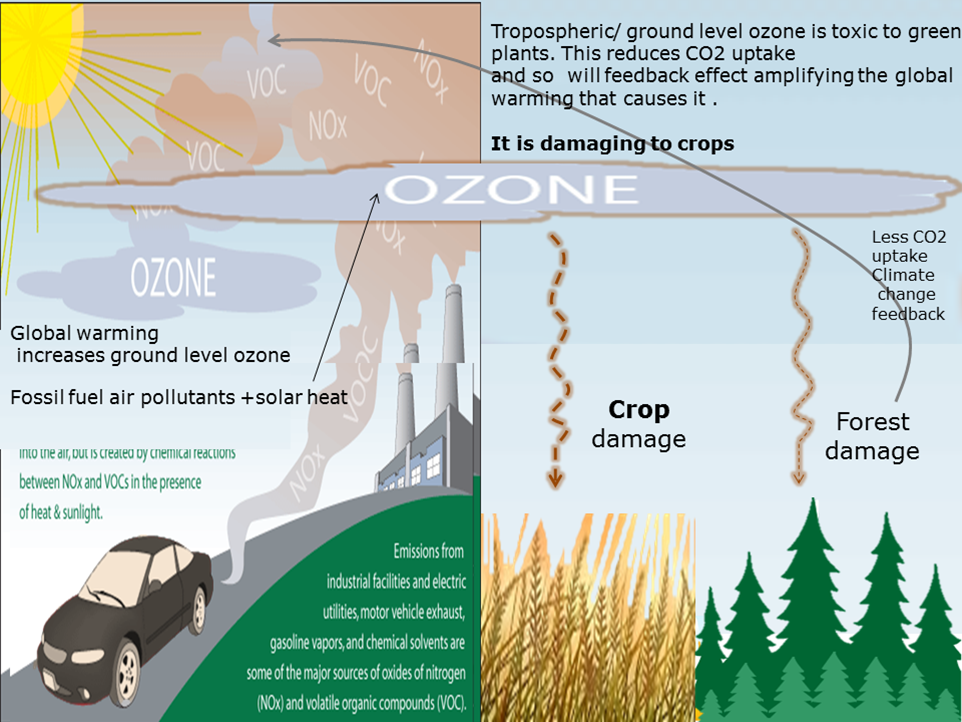
Our results suggest that O3 pollution poses a growing threat to global food security even under an optimistic scenario of future ozone precursor emissions.
The yields of major crops across the globe are already being significantly inhibited by exposure to surface ozone.
In the A2 scenario the global year 2030 yield loss of wheat due to O3 exposure is up to 26% (a further reduction in yield of up to 10% from year 2000 values), up to 19% for soy bean (further reduction of up to 11%), and up to 8.7% for maize (further reduction up to 3.2%).
(Global crop yield reductions due to surface ozone exposure Year 2030 potential crop production losses and economic damage under two scenarios of O3 pollution Shiri Avnery et al Atmospheric Environment 2011)
The yields of major crops across the globe are already being significantly inhibited by exposure to surface ozone.
In the A2 scenario the global year 2030 yield loss of wheat due to O3 exposure is up to 26% (a further reduction in yield of up to 10% from year 2000 values), up to 19% for soy bean (further reduction of up to 11%), and up to 8.7% for maize (further reduction up to 3.2%).
(Global crop yield reductions due to surface ozone exposure Year 2030 potential crop production losses and economic damage under two scenarios of O3 pollution Shiri Avnery et al Atmospheric Environment 2011)
Ainsworth's study, together with her previous field experiments, have all but wiped out early hopes that increased carbon dioxide might be enough to overcome the other factors and boost yields (D Taub).
Increasing ground level ozone due to global warming will have a devastating effect on crops (July 2014 MIT).
The effect of increasing ground level ozone toxicity to green plants with global warming is not included in the IPCC's climate crop models, though an assumed potential benefit of increased ambient CO2 is included. Increased ground level ozone as well as higher temperatures (causing ground level ozone increase) will wipe out any possible benefit from increased CO2.
The effect of increasing ground level ozone toxicity to green plants with global warming is not included in the IPCC's climate crop models, though an assumed potential benefit of increased ambient CO2 is included. Increased ground level ozone as well as higher temperatures (causing ground level ozone increase) will wipe out any possible benefit from increased CO2.
Although several studies confirm TAR findings that elevated CO2 may ameliorate otherwise negative impacts from ozone (Kaakinen et al., 2004), the essence of the matter should be viewed the other way around: increasing ozone concentrations in future decades, with or without CO2 increases, with or without climate change, will negatively impact plant production, possibly increasing exposure to pest damage (Ollinger et al., 2002; Karnosky, 2003). Current risk-assessment tools do not sufficiently consider these key interactions. Improved modelling approaches that link the effects of ozone, climate change, and nutrient and water availability on individual plants, species interactions and ecosystem function are needed (Ashmore, 2005) IPCC 2007
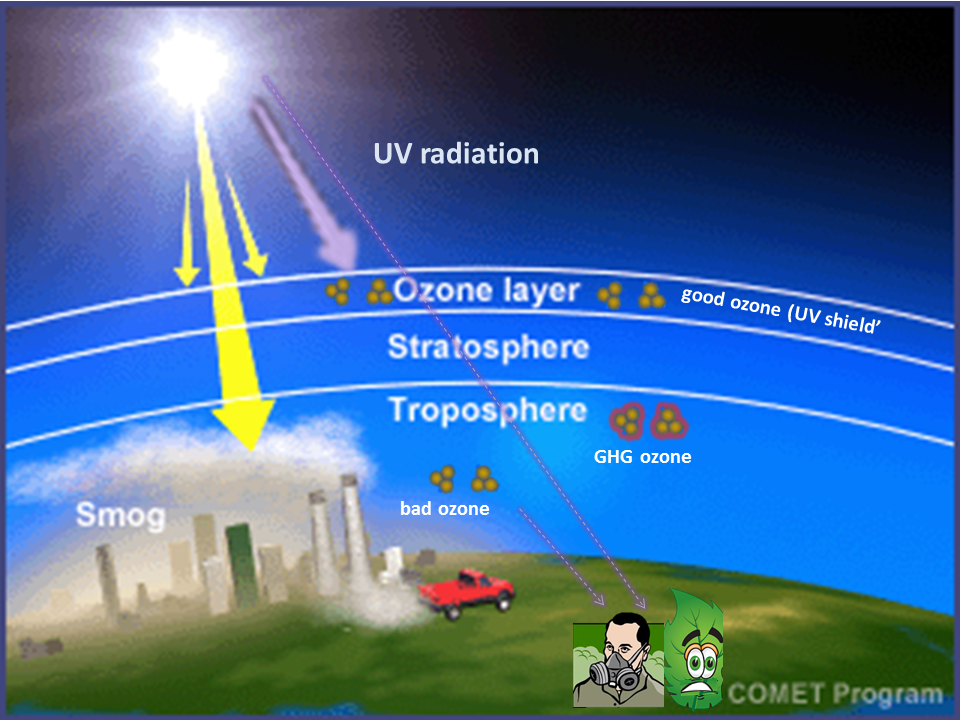
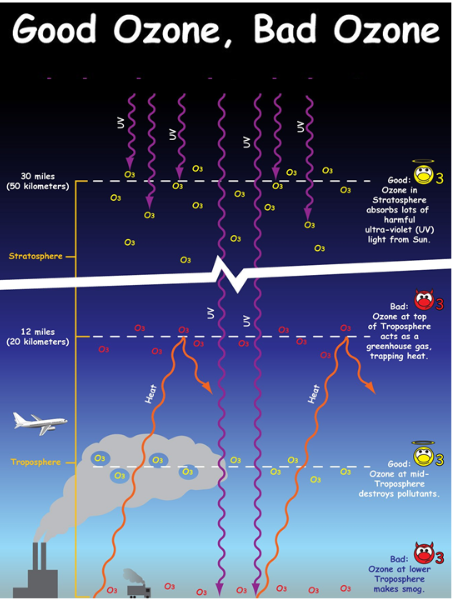
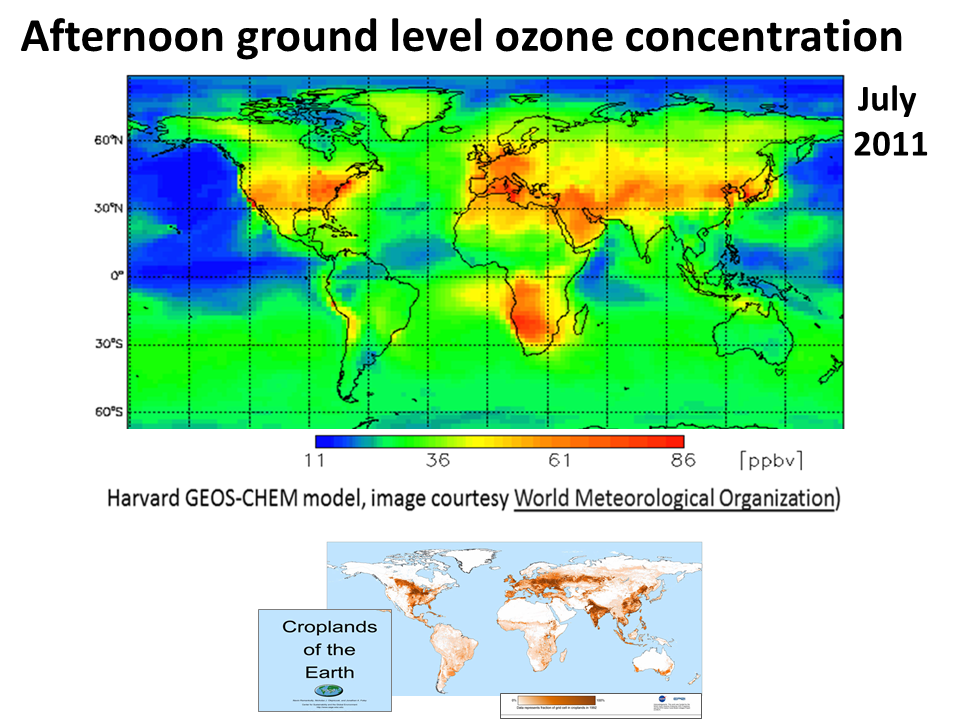
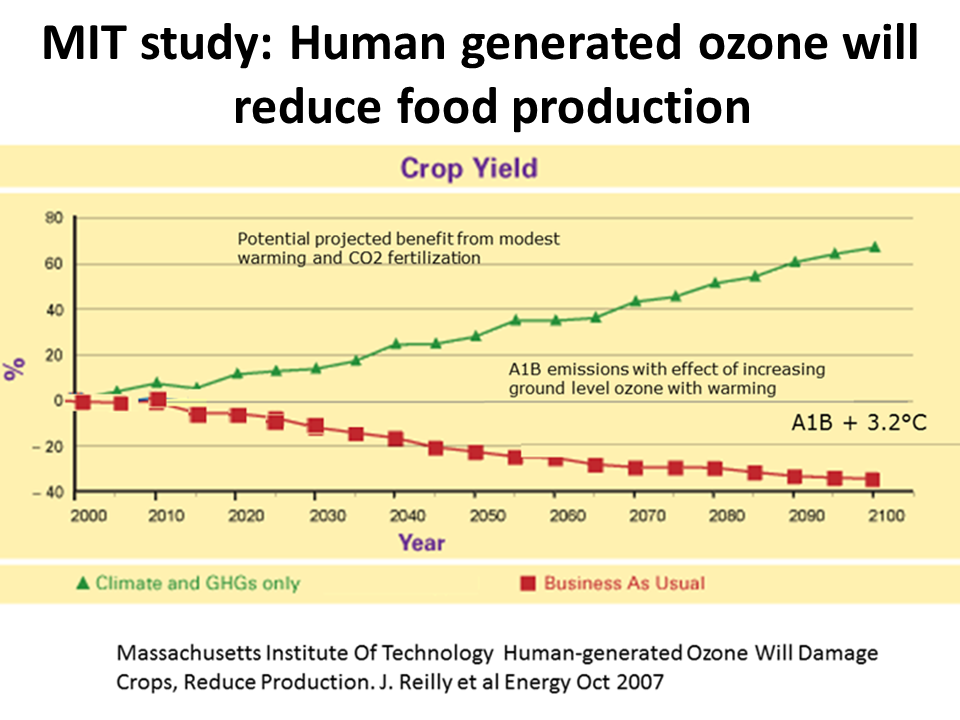
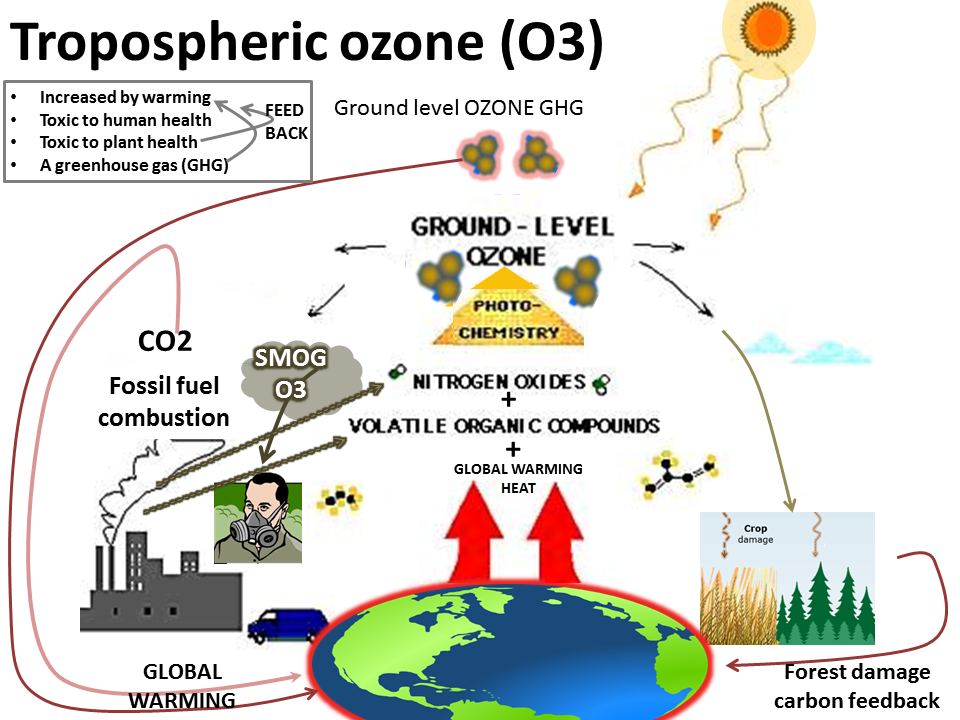
Tropospheric ozone has many complex interactions, important to health and food security, that makes it a highly dangerous emission, produced by fossil fuel pollution chemicals reacting chemically catalyzed by light and heat originating from the sun.
Its damaging effect on human and crop health has a regional aspect. Note how the global ozone distribution map (above) it is concentrated on the worlds best producing regions in the northern hemisphere.
IPCC AR5 2014 WG2 TS 7.2.1 Emissions of CO2 have also been associated with ozone (O3) precursors that have driven a rise in tropospheric O3 that harms crop yields (Morgan et al., 2006; Mills et al., 2007). There is high confidence (high agreement, robust evidence) that elevated O3 has suppressed global production of major crops, with estimated losses of roughly 10% for wheat and soybean and 3-5% for maize and rice (Van Dingenen et al., 2009). Impacts are most severe over India and China, but are also evident for soybean in the United States in recent decades (Fishman et al., 2010).
There is high confidence that elevated O3 has suppressed global production of major crops, with estimated losses of roughly 10% for wheat and soybean and 3-5% for maize and rice IPCC AR5
September 2014 Ozone pollution in India each year kills enough crops to feed 94 million in poverty
March 2014 Nature Threat to future global food security from climate change and ozone air pollution A. P. K. Tai. According to these projections, more severe ozone pollution (scenario RCP8.5) leads to substantial crop damage on a global scale, reducing global total crop production by 3.6%. In this scenario, ozone pollution and climate change combine to reduce global crop production by 15% between 2010 and 2050.
March 2014 Nature Threat to future global food security from climate change and ozone air pollution A. P. K. Tai. According to these projections, more severe ozone pollution (scenario RCP8.5) leads to substantial crop damage on a global scale, reducing global total crop production by 3.6%. In this scenario, ozone pollution and climate change combine to reduce global crop production by 15% between 2010 and 2050.
July 2016 D Shindell Crop yield changes induced by emissions of individual climate altering pollutants
SURFACE OZONE INCREASES WITH GLOBAL WARMING.
Tropospheric/ground/surface level ozone is formed in the air from a chemical reaction between air polltants capatalysed by the sun's heat. Therefore surface ozone will increase with the degree of global warming (a self amplifying feedback)
Tropospheric/ground/surface level ozone is formed in the air from a chemical reaction between air polltants capatalysed by the sun's heat. Therefore surface ozone will increase with the degree of global warming (a self amplifying feedback)